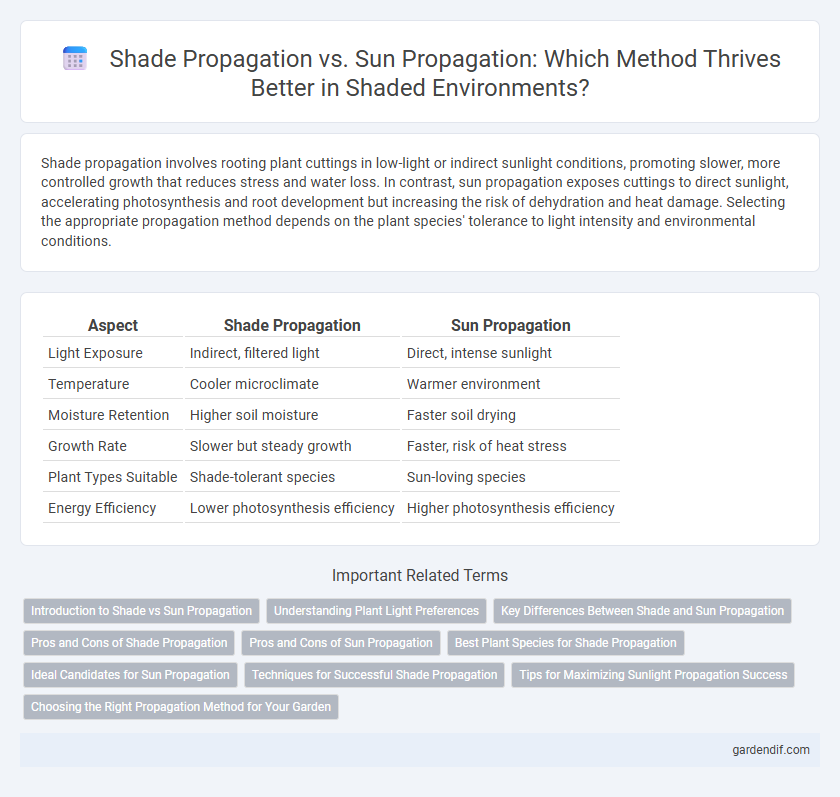
Shade propagation vs sun propagation Illustration
Shade propagation involves rooting plant cuttings in low-light or indirect sunlight conditions, promoting slower, more controlled growth that reduces stress and water loss. In contrast, sun propagation exposes cuttings to direct sunlight, accelerating photosynthesis and root development but increasing the risk of dehydration and heat damage. Selecting the appropriate propagation method depends on the plant species' tolerance to light intensity and environmental conditions.
Table of Comparison
| Aspect | Shade Propagation | Sun Propagation |
|---|---|---|
| Light Exposure | Indirect, filtered light | Direct, intense sunlight |
| Temperature | Cooler microclimate | Warmer environment |
| Moisture Retention | Higher soil moisture | Faster soil drying |
| Growth Rate | Slower but steady growth | Faster, risk of heat stress |
| Plant Types Suitable | Shade-tolerant species | Sun-loving species |
| Energy Efficiency | Lower photosynthesis efficiency | Higher photosynthesis efficiency |
Introduction to Shade vs Sun Propagation
Shade propagation is a method of plant propagation that thrives in low-light or indirect sunlight conditions, promoting root development and reducing water loss through evaporation. Sun propagation relies on direct sunlight to encourage faster growth and increased photosynthetic activity, ideal for sun-loving plant species. Understanding the differences between shade and sun propagation helps optimize growth environments for specific plant varieties, enhancing propagation success rates.
Understanding Plant Light Preferences
Shade propagation suits plants adapted to low light, ensuring optimal growth by mimicking their natural understory environment. Sun propagation benefits species requiring high light intensity for photosynthesis and flowering, promoting vigor and productivity. Understanding plant light preferences guides propagation methods, enhancing survival rates and development.
Key Differences Between Shade and Sun Propagation
Shade propagation typically requires lower light intensity and cooler temperatures, making it ideal for plants sensitive to direct sunlight. Sun propagation, on the other hand, relies on full-spectrum, intense light to promote faster photosynthesis and root development. Understanding these differences is crucial for optimizing growth conditions and selecting the appropriate propagation method for specific plant species.
Pros and Cons of Shade Propagation
Shade propagation offers advantages such as reduced water evaporation and protection from direct sunlight, minimizing heat stress on developing plants. However, it can also slow the growth rate due to limited photosynthesis and increase susceptibility to fungal diseases in high humidity environments. Compared to sun propagation, shade propagation is beneficial for delicate or shade-loving species but may require more careful monitoring to prevent mold and ensure adequate light exposure.
Pros and Cons of Sun Propagation
Sun propagation accelerates plant growth by providing direct, intense light essential for photosynthesis, leading to faster development and stronger seedlings. However, excessive sun exposure can cause dehydration, leaf scorch, and stress, particularly for shade-adapted species, reducing overall survival rates. Controlled sun propagation requires balancing light intensity with adequate water and temperature management to maximize growth benefits while minimizing damage.
Best Plant Species for Shade Propagation
Best plant species for shade propagation include ferns, hostas, and begonias, which thrive with limited direct sunlight and maintain vibrant foliage. These plants exhibit efficient chlorophyll production and optimized photosynthesis under low-light conditions, ensuring successful propagation and growth. Shade-tolerant plants generally require less water and experience reduced stress compared to sun-exposed species during propagation.
Ideal Candidates for Sun Propagation
Ideal candidates for sun propagation include sun-loving plants such as tomatoes, peppers, and basil, which require full sunlight to thrive and develop strong growth. These species benefit from direct, intense light exposure that enhances photosynthesis and accelerates germination. Sun propagation maximizes energy absorption, resulting in healthier, more vigorous seedlings compared to shade propagation.
Techniques for Successful Shade Propagation
Cuttings taken in shaded environments require precise control of humidity and temperature to promote root development while minimizing stress. Employing misting systems and using rooting hormones can significantly enhance success rates by maintaining moisture and stimulating root growth. Select shade-tolerant plant species and utilize indirect light or filtered sunlight to optimize photosynthesis during the propagation phase.
Tips for Maximizing Sunlight Propagation Success
Maximizing sunlight propagation success involves selecting plants that naturally thrive in full sun conditions, ensuring they receive at least six to eight hours of direct sunlight daily. Using reflective surfaces or light-colored mulch can enhance light exposure, while regularly rotating containers promotes even growth and prevents shade from other plants. Maintaining optimal soil moisture and temperature further supports photosynthesis and root development, crucial for healthy propagation under sun conditions.
Choosing the Right Propagation Method for Your Garden
Shade propagation excels for plants that thrive in low light, such as ferns and hostas, ensuring healthier root development and less stress during early growth stages. Sun propagation suits sun-loving species like tomatoes and peppers, promoting robust photosynthesis and faster growth under direct sunlight. Selecting the right propagation method depends on the plant's light requirements and adapting propagation conditions to mimic natural habitats for optimal survival and yield.
Shade propagation vs sun propagation Infographic

 gardendif.com
gardendif.com